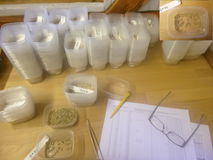Development of a new population of summer rye for organic farming in Lower Saxony
This is a model project in which a little-used crop such as summer rye, which is however a very sensible alternative for certain organic farming locations such as sandy, low-nutrient, drought-prone locations, is made more attractive by means of variety development and conservation efforts adapted to the intensity of use, which could then be achieved in the long term. The selection is deliberately made under the extensive and at the same time ecological conditions typical for the crop.
Ecologically produced summer rye seed is used in Lower Saxony to an extremely above-average extent compared to the federal territory, which is due to its special suitability for sandy locations which are widespread in northern Germany and at the same time its potential suitability as bread cereal. However, since summer rye is of only minor cultivation significance overall, the range of varieties developed under more or less intensive conventional cultivation conditions is also very small. Therefore, at the suggestion of the producer association Öko-Korn-Nord, a start was made in 2010 to initially cultivate a light grain rye eliteramsch from the winter rye breeding in Darzau on 270m² in spring.
The ears of grain ripened from the first cultivation were sown in 2011 on nine small plots as single ear offspring alongside a summer rye pea mixture with the summer rye variety Arantes. In 2012, 21 small plots were then planted, including some genetic resources from the IPK Gatersleben gene bank. In 2013, a small assortment of pre-selected land varieties was added by the Swedish cereal researcher Hans Larsson, so that the total number of small plots grew to 40, from which about 600 single ears were harvested by hand. On the mother's side, 60% of the selected ears came from light grain rye, 15% from Arantes and 25% from 18 different genetic resources. This created the basis for further breeding work. Up to this point, the work in Darzau's cereal breeding research could still be listed as an appendix to the summer barley, the processing of which had been funded by the Future Foundation for Agriculture.
To isolate the summer rye plots from cross-pollination, they are planted in a summer barley field and care is taken to ensure that no other summer rye is grown within a radius of at least one kilometre. Due to the fact that the flowering time is about two weeks later than that of winter rye, the risk of pollination of winter rye can be neglected, although it is a common occurrence in the region.
With the support of the State of Lower Saxony (Lower Saxony Ministry of Food, Agriculture and Consumer Protection), it was then possible for the first time in 2014 to cultivate 480 single-crop offspring on 80 small plots of 1m² each with 6 rows of drills, whereby offspring descending from genetic resources were still between those that were based on light grain rye or arantes, so that a last good crossbreeding was made possible. Very long single plants were removed before flowering. Since all lines that were traced back to genetic resources were particularly long, weak and susceptible to mildew, no more single plants were harvested from them. The threshing of the plots, in which six offspring, each of which was already closely related to the other, were threshed together, allowed the determination of the thousand-grain weights (TKG) and the starch gelatinization. The average TKG in the population was 40g and the starch viscosity, measured in Rapid Visco Units (RVU), was 120, which is below average compared to winter rye. Since individual plants with two ears of corn each had already been harvested, 160 small plots (1m² net area) could be planted in 2015 from 160 individual plant offspring, so that individually threshed plots could be traced back to a mother plant from the previous year for harvesting. In 2016, the procedure was the same as in the previous year, but now single ears had to be harvested from the mother plant progeny again, as not enough grains could have been harvested from just one plant due to the fact that sowing was only possible in mid-April and the subsequent relatively weak development, so that a complete small plot of land could not be stocked again. At this stage of population development, such flexibility in the approach is essential. For the 2017 sowing season, the proportion of offspring descended from light grain rye via the mother tree has increased to over 85% of all plots. However, the characteristic features of light grain rye are still very much spread throughout the population and even the large ears typical of light grain rye are still being sought in vain. The vegetation is too short for this, with a maximum of 150 days for summering as opposed to around 300 days for wintering. The selection procedure can classically be described as a dam line selection, since the ancestry can only be traced back via the dam lines, but the pollen donor can theoretically come from almost all neighbouring plots, although the origin from the very next ones is more likely. A modification of the pollen cloud is only possible by taking single plants before flowering.
For the 2018 sowing, the size of the breeding garden was reduced to 720 single ears offspring for the 2018 sowing, based on the results of the first yield test carried out in parallel in 2017, which can be traced back to 120 ears offspring from the previous year. From these microplots 500 single plant offspring with two ears per plant were harvested and reduced to 160, which were sown again in 2019 as single plant offspring on 160 microplots. Unfortunately, a hailstorm in mid-June 2019 decimated the achievable harvest quantities to such an extent that again not enough seed could be harvested for a yield test in 2020. However, the selection was intensified to reduce susceptibility to brown rust and all grey-green grains were completely removed from the individual plant offspring, so that the transition to complete light grain size can now be completed more quickly. However, this will then lead to a reduction of the breeding garden to 60 microplots in 2020, from which individual plant offspring for 160 small plots can only be taken in 2021.

With the support of the State of Lower Saxony (Lower Saxony Ministry of Food, Agriculture and Consumer Protection) and co-funding of Öko-Korn-Nord, the breeding garden could be continued in 2019 with 160 individual plant offspring in one small plot each. Compared to the previous year, mildew and brown rust were again clearly visible. Unfortunately, a hailstorm hit this trial area particularly hard, so that stalks were bent and shredded and about 40% was lost. In the selection of individual plants, the resistance to rust was taken into account, but the infestation continued to develop very strongly, so that in the end only seventeen selected individual plants remained almost rust-free. Although it was possible to maintain the level with regard to high thousand-grain weight and medium-high number of cases - recorded in the small plot thrush - the correlation of the values compared to the previous year's values of the respective breeding lines was hardly pronounced. It was not possible to determine whether this is due to the extremely different cultivation and location conditions of the years 2017 to 2019, mainly due to the weather contrasts, or to a stronger cross-pollination under the respective conditions. The correlations were at a significantly higher level in previous years.
The circumstances were taken as an opportunity to make the transition from approx. 30% light grain to almost 100% by removing all grey-green grains from the single plant threshing with tweezers. According to the planning, this was to be done more successively at a later date, but due to the inevitable harvest restriction and the associated diversity spread due to the lack of an increase in selection intensity at this point in time, it was only possible to harvest single plants again in 2020 anyway, for hopefully a small plot cultivation in 2021 with threshing, and yield testing in 2022. It simply takes time.
The two years 2015 and 2016 form the transition from the creation of diversity to variety-specific uniformity, not only from the impressions the plots made on the observer, but also in the correlations of starch gelatinization and harvest quantity compared to the previous year. It can currently be expected that it will not be possible to test sufficiently homogeneous seed of this population variety, which will then be adapted to organic farming, under practical conditions until 2021 at the earliest.
...a vigour in juvenile development is combined with an average stand height to maturity and satisfactory resistance to black rust, mildew and leaf spots. Pronounced stability with medium-length, overhanging ears must not be lacking, with sufficiently stable growth and starch viscosity of as large grains as possible with a mild taste. The latter not only for bread making, but also so that the harvest can be used for feeding if necessary. The variety should not be restricted too much in order to keep open in principle a modification of the population by another breeder at a different location using a comparable procedure, but starting later in the process, because this is conceptually desirable.
The following were, are and will be made possible
The project was initially supported by the Seed Fund of the Future Foundation for Agriculture (2010-2013) and then by the State of Lower Saxony (2014 - 2019) and Öko-Korn-Nord (2016-2019). It is desirable to be able to continue the project to practical cultivation maturity with the support of processors, growers and rye lovers not only from Lower Saxony. So far, it has to be promoted anew every year. The project expenditure is to be kept below 25,000 €/year in order to remain recognisable as a model for the constant further development of a crop of lesser cultivation significance, so that it does not lose touch with the further development of the main crop types or even fall victim to complete insignificance. Please help us on this way with your donation.The next results from cultivation, processing and analysis will be published on this website at the end of 2020.



